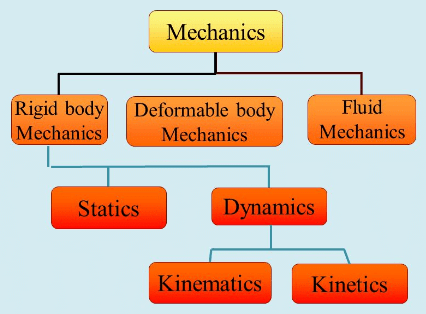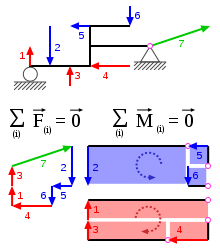Civil Engineering (CE) Exam > Civil Engineering (CE) Notes > Engineering Mechanics > Basics of Mechanics
Basics of Mechanics | Engineering Mechanics - Civil Engineering (CE) PDF Download
Introduction
- From the very childhood, we have seen footballs bouncing and wheels rolling. We might have wondered how all these motions happen. These all motions are the interaction of different bodies and the effect of forces acting on them.
- The branch of science dealing with the effect of forces on bodies is called Mechanics. The principles of Mechanics are exactly applicable to machines, it may be a simple machine such as a liver or bicycle or a machine as complex as an aircraft.

- When Mechanics is applied in Engineering, design, and analysis of mechanisms and machines, it is known as Engineering Mechanics.
- When bodies interact and forces act between them there are two possibilities, they may move or they may remain static. The branch of Engineering Mechanics dealing with the motion of bodies is known as Dynamics and the other branch is known as Statics, in which we study the balance and equilibrium of bodies.
- Throughout the study of Engineering Mechanics, the principles of three Newton's Laws of Motion are used invariably. So complete understanding of these laws is a must.
- Along with this, as the physical quantities encountered during engineering analyses are mostly vectors, adequate knowledge of vector algebra is required.
Statics
- This branch of engineering mechanics deals with bodies in equilibrium and are not moving with respect to the frame of reference considered for analysis.
- Bodies may be experiencing different forces but the configuration of these forces is such that the resultant force on the system is zero. The unbalanced forces tend to accelerate a body but if the net force is zero the body will not accelerate.
- In addition to accelerating a body forces make bodies rotate. This ability of a force to rotate a body is known as torque or moment of the force.
- For true static equilibrium, the net moment or torque on a body should also be zero along with zero net force.

- Statics include force analysis in stationary structures such as trusses, frames, and machines at certain stationary positions. Cables and strings in stationary positions in mechanical systems also come under the purview of statics.
Question for Basics of MechanicsTry yourself:In Theory of machines ____ deals with various forces when the body is stationary.
View Solution
Dynamics
- The analysis of forces and motion in moving bodies comes in Dynamics.
- This branch of engineering mechanics is further divided into two branches:
(i) Kinematics deals with the analysis of the motion of bodies without considering the forces causing or associated with these motions. In Kinematics the position, velocity, and acceleration of certain points and the members of mechanisms and machines are studied. The kinematic analysis starts with particles and is then extended to rigid bodies. (ii) Kinetics includes analysis of causal force, impulse, and momentum of bodies. The forces causing motion in bodies are studied under kinetics. The concept of work and energy and its application for the analysis of mechanical systems also comes in this branch of dynamics.
(ii) Kinetics includes analysis of causal force, impulse, and momentum of bodies. The forces causing motion in bodies are studied under kinetics. The concept of work and energy and its application for the analysis of mechanical systems also comes in this branch of dynamics.
Question for Basics of MechanicsTry yourself:______ is the study to know the displacement, velocity and acceleration of a part of the machine.
View Solution
The document Basics of Mechanics | Engineering Mechanics - Civil Engineering (CE) is a part of the Civil Engineering (CE) Course Engineering Mechanics.
All you need of Civil Engineering (CE) at this link: Civil Engineering (CE)
|
24 videos|69 docs|53 tests
|
FAQs on Basics of Mechanics - Engineering Mechanics - Civil Engineering (CE)
| 1. What is mechanics in GATE and what are its branches? |  |
Ans. Mechanics is a branch of engineering that deals with the study of objects in motion and the forces that cause the motion. It is an important topic in the GATE exam for engineering students. The two main branches of mechanics are Statics and Dynamics. Statics deals with the equilibrium of forces acting on objects that are at rest, while Dynamics deals with the motion of objects under the influence of forces.
| 2. What are the basics of mechanics in GATE? |  |
Ans. The basics of mechanics in GATE include the study of motion, forces, and energy. Students should have a clear understanding of concepts such as displacement, velocity, acceleration, Newton's laws of motion, work and energy, and momentum. These concepts are essential for solving problems related to mechanics in the GATE exam.
| 3. How to prepare for mechanics in GATE? |  |
Ans. To prepare for mechanics in GATE, students should start by understanding the basics of the subject. They should focus on understanding concepts rather than memorizing formulas. Solving previous years' question papers and taking mock tests can help students get familiar with the exam pattern and types of questions asked. It is also important to practice numerical problems and work on time management skills.
| 4. What kind of questions are asked in mechanics in GATE? |  |
Ans. The questions asked in mechanics in GATE are generally numerical problems that require students to apply the concepts they have learned. Some of the common types of questions include finding the velocity or acceleration of an object, determining the force acting on an object, and calculating the work done or energy consumed by a system. The questions may also involve the use of diagrams and graphs.
| 5. What are some important topics to focus on for mechanics in GATE? |  |
Ans. Some important topics to focus on for mechanics in GATE include kinematics, Newton's laws of motion, work and energy, momentum, and rotational motion. Students should also be familiar with topics such as friction, elasticity, and fluid mechanics. It is important to have a strong understanding of the basics before moving on to more complex topics.
Related Searches

















